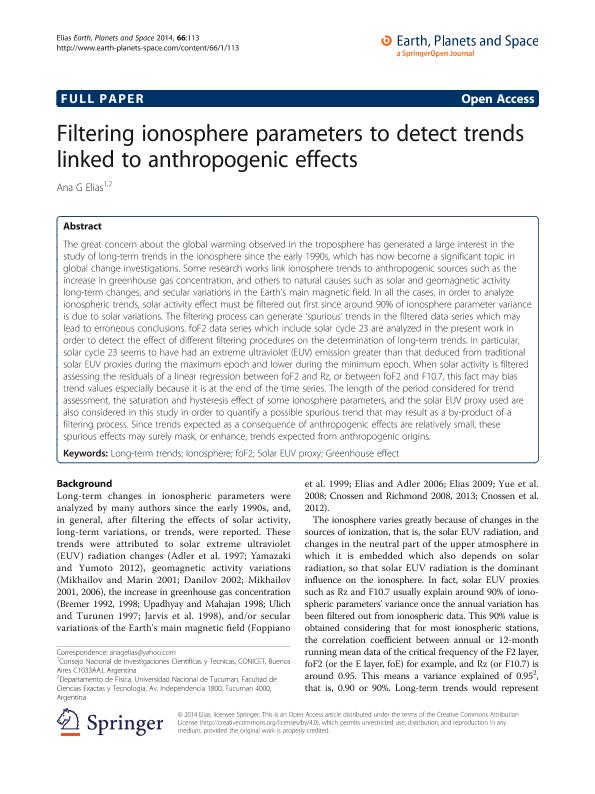Mostrar el registro sencillo del ítem
dc.contributor.author
Elias, Ana Georgina

dc.date.available
2016-08-22T14:11:50Z
dc.date.issued
2014-09
dc.identifier.citation
Elias, Ana Georgina; Filtering ionosphere parameters to detect trends linked to anthropogenic effects; Springer; Earth, Planets and Space; 66; 9-2014; 113-123
dc.identifier.issn
1880-5981
dc.identifier.uri
http://hdl.handle.net/11336/7258
dc.description.abstract
The great concern about the global warming observed in the troposphere has generated a large interest in the study of long-term trends in the ionosphere since the early 1990s, which has now become a significant topic in global change investigations. Some research works link ionosphere trends to anthropogenic sources such as the increase in greenhouse gas concentration, and others to natural causes such as solar and geomagnetic activity long-term changes, and secular variations in the Earth´s main magnetic field. In all the cases, in order to analyze ionospheric trends, solar activity effect must be filtered out first since around 90% of ionosphere parameter variance is due to solar variations. The filtering process can generate ?spurious? trends in the filtered data series which may lead to erroneous conclusions. foF2 data series which include solar cycle 23 are analyzed in the present work in order to detect the effect of different filtering procedures on the determination of long-term trends. In particular, solar cycle 23 seems to have had an extreme ultraviolet (EUV) emission greater than that deduced from traditional solar EUV proxies during the maximum epoch and lower during the minimum epoch. When solar activity is filtered assessing the residuals of a linear regression between foF2 and Rz, or between foF2 and F10.7, this fact may bias trend values especially because it is at the end of the time series. The length of the period considered for trend assessment, the saturation and hysteresis effect of some ionosphere parameters, and the solar EUV proxy used are also considered in this study in order to quantify a possible spurious trend that may result as a by-product of a filtering process. Since trends expected as a consequence of anthropogenic effects are relatively small, these spurious effects may surely mask, or enhance, trends expected from anthropogenic origins.
dc.format
application/pdf
dc.language.iso
eng
dc.publisher
Springer

dc.rights
info:eu-repo/semantics/openAccess
dc.rights.uri
https://creativecommons.org/licenses/by-nc-sa/2.5/ar/
dc.subject
Long-Term Trends
dc.subject
Ionosphere
dc.subject
Solar Euv Proxy
dc.subject
Greenhouse Effect
dc.subject.classification
Meteorología y Ciencias Atmosféricas

dc.subject.classification
Ciencias de la Tierra y relacionadas con el Medio Ambiente

dc.subject.classification
CIENCIAS NATURALES Y EXACTAS

dc.title
Filtering ionosphere parameters to detect trends linked to anthropogenic effects
dc.type
info:eu-repo/semantics/article
dc.type
info:ar-repo/semantics/artículo
dc.type
info:eu-repo/semantics/publishedVersion
dc.date.updated
2016-08-17T15:40:10Z
dc.journal.volume
66
dc.journal.pagination
113-123
dc.journal.pais
Alemania

dc.journal.ciudad
Berlin
dc.description.fil
Fil: Elias, Ana Georgina. Universidad Nacional de Tucumán. Facultad de Ciencias Exactas y Tecnologia; Argentina. Consejo Nacional de Investigaciones Científicas y Técnicas. Centro Científico Tecnológico Tucumán; Argentina
dc.journal.title
Earth, Planets and Space
dc.relation.alternativeid
info:eu-repo/semantics/altIdentifier/url/https://earth-planets-space.springeropen.com/articles/10.1186/1880-5981-66-113
dc.relation.alternativeid
info:eu-repo/semantics/altIdentifier/doi/10.1186/1880-5981-66-113
dc.relation.alternativeid
info:eu-repo/semantics/altIdentifier/doi/http://dx.doi.org/10.1186/1880-5981-66-113
Archivos asociados
